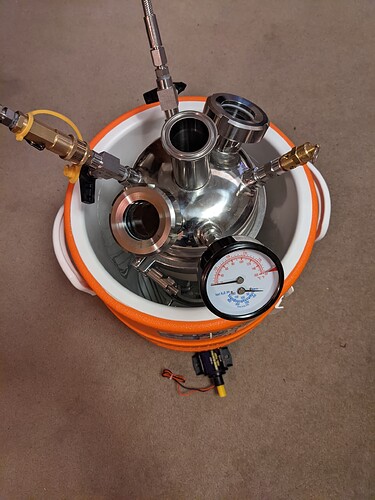I’ve learned a lot of great information from ya’lls posts for a month or so and I sure appreciate the time invested and knowledge shared. Most of my questions have been asked and answered ad nauseum, though I’ve seen the same gurus offer different answers depending on what systems/processes are being used. I only ask again to ensure I am not missing important nuances, please don’t take it as disregard for your time.
In designing this rig/process my priorities were to safely, consistently do two runs of the same material quickly while operating solo outdoors mostly one-handed (so my right hand can be ready for the unexpected). The decision to do two runs was to accommodate the quality/quantity trade-off. I am making carts and chocolate bars from the product, so I plan to do one 5-min soak or rinse (high quality), purge the collection chamber, swap splatter platters, and do a second 30min soak (food grade) and then purge the collection AND material chamber.
For context, I have a pretty standard 1lb system with a jacketed material chamber, inline sight glass, hemi lid with 2 sight glasses, conical (not hemi) mat chamber reducer, 1.5" valve etc. I added two 6"x18" (oversized intentionally) SS solvent storage tanks (donor and recipient) so that I can purge faster as well as dry butane and clean alternating tanks between each run. I also attached temp/pressure gauges anywhere there is a valve, added high-flow quick-connects (after distilling butane with and without, they slowed things a tiny bit but way worth it), added PRV and manual release valves, and bought a 3"x18" mole sieve to use between runs (not during until I have a rack and more experience).
I also bought a few 3" filter housings but decided to wait on them because they may cause slowing from resistance or vapor lock and if I have an issue I want a simpler troubleshooting process. I got some CRX and a 6" chamber/assembly for CRC, shold I also wait to add this complicatio? I wonder about using filter plates that can slide into the base of the material chamber (like this). Beyond that I just have typical accessories like refrigerant scale, laser thermometer (I added tape to SS components so I can get a temp), combustible vapor detector, and insulated super grip gloves.
I’ve learned that I should replace the single hinge clamps with double bolted ones and probably get solvent res lids with both vapor and liquid ports in them. I also wonder about getting a hemi reducer with a 1/4" inlet to allow me to bottom fill.
I’m using Dried (60% humidity) cured bud, should I dry it further prior to freezing?
Should I break material down to marble sized nugs with minimal breakage, or crush/grind it?
I plan to freeze the bud under vacuum, is this required for dry material or just fresh frozen
I have a co2 tank and 0-200psi regulator, is this an appropriate substitute for nitro? I understand that I must avoid storing liquified co2 which is certainly possible as my system will hopefully get below -70f and may accidentally get above 60psi. I installed a 100psi PRV and would manually purge the co2 from the collection chamber prior to attempting solvent recovery.
Does it make sense to pack bud in several felt sock filters (75/25/10), or would solvent just channel around the outside of the material? Would soaking make this a non-issue?
I prefer felt filters over nylon mesh for depth/capacity, can I cut felt into disks and use it on a filter-plate instead of steel mesh or coffee filter?
I plan to start with .5lb runs (1lb system) so I get more experience under my belt, would it make sense to use steel balls to dewax bottom half of jacketed extraction chamber?
Also, I have a decent bit of frozen Kief, any tips on running this through a CLS without clogging??
I plant to start with dry ice/isopropyl in the material chamber sleeve (MCS), and then at the end fill it with 190* water. Should I worry about the thermal shock impacting the equipment?
It looks like I should insulate the material chamber below the sleeve to prevent vapor lock. Is there any reason not to make a Reflectix cover to insulate the material chamber sleeve as well?
Right now weekly outside temp undulates between 0f and 40f, and am using fluids that range from -100* to +100* for extended periods. Would it be best to shoot for a warmer day if I have more dry ice than water heating capacity? I am already using 5gal beverage coolers with reflectix baffles to mitigate heat transfer with outside air. I’ve also read that colder is better in terms of quality, should I shoot for a cold day to prevent marginal heat transfer into the system?
My solvant is mostly neon N-butane with some whip-it tri-mix, using MSDS and partial-pressure info I determined it has an evaporation point of +23.18*f.
I understand that thermal differential is the primary source of flow, but want to keep the extraction chamber as cold as possible for a clean product. Does it make sense to surround both the material and recovery chamber with iso/dry-ice (-100f) in and rely on intentionally warmer (-25f) solvent to warm the material chamber and encourage migration to the colder collection chamber? The collection chamber will have several-fold the volume of iso and dry-ice surrounding it.
Thanks in advance for the help! Some of you guys are personal heroes and I’m excited to join the conversation, even if I only know enough to ask questions.

